Eg Ur Expedition ~ 2024
Even if the plan is to talk about fishing, no discussion of Mongolia is complete without mention of its greatest hero, Chinggis Khan. The infamous warrior is known primarily for military innovation, pillaging civilizations, spreading his genetic material, and absolutely razing entire cities from the face of the earth. Within Mongolia, Chinggis inspires substantial national pride, with everything from the international airport to the most popular beer named for the fearsome conqueror. Undoubtedly, Chinggis is one of the most important historical figures of all time. However, the magnitude of his legacy extends far beyond the brutal acts for which he is largely recognized. Chinggis continues to impact modernity through the economic and cultural exchanges he facilitated. After the initial conquest, in return for loyalty and a bit of tribute, Chinggis and the Mongols were unusually tolerant of culture, religion, and local economic hegemony. The Mongols unabashedly borrowed ideas from other cultures, and their dominance in Asia allowed these innovations to spread like never before.
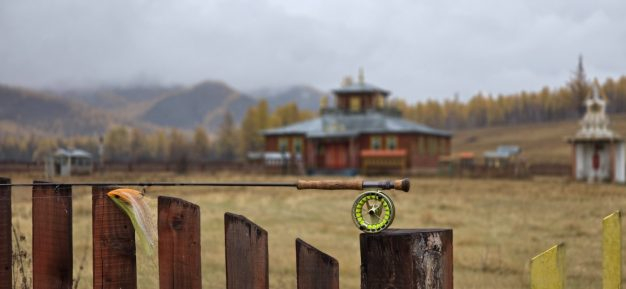
The Silk Road was less of an actual pathway and more of a conceptualization of the thriving merchantry that occurred across Asia during this time frame. Although the Silk Road existed for centuries before Chinggis’ birth in the 12th century, his rise to power led to an explosion of trade and an immense transaction of ideas between the Chinese, the Islamic empires, the Europeans, the nomadic herdsmen of the steppe, and the multitudes of other peoples throughout the Eurasian world. The Silk Road arguably reached its zenith under Chinggis and his descendant Khans.

As a fisherman arriving in Mongolia, the legacy of the Silk Road was much more apparent than that of any violent tradition passed down from the Mongol Empire. Modern Mongolia maintains the spirit of international cooperation it fostered with the Silk Road during the Chinggis’ time. Sandwiched between China and Russia, Mongolia’s unique geopolitical position essentially requires that it does so. This is still a land where people come and go, sharing goods and ideas along the way. The grungy capital city of Ulaanbaatar is exploding with growth, as foreign mining interests attract people from around the globe to this bustling metropolis. Cranes peer over half-finished high rise apartment buildings in nearly every corner of Ulaanbaatar as the city strains to accommodate migrants seeking these economic opportunities. Many of the Mongolians we met had traveled to the United States or Europe to receive an education, returning with new skills to further improve their home country.
 The hum of the grind was not limited to the urban area. Nomadic pine nut gatherers were the first to greet us as we debarked from our plane on the dirt airstrip in the northern mountains. These foragers traveled hundreds of miles on their motorbikes from the western fringes of the country to collect these prized seeds, which they planned to sell or trade back home. Roughly 40% of Mongolians continue to live nomadic or semi-nomadic lives, and they are going about their business with as much fervor as their urban counterparts. Everywhere I traveled in Mongolia, the people were kind, helpful, on the move, and hustling. The legacy of Chinggis Khan lives on in Mongolia, but in the form of the commercial boom he facilitated with the Silk Road rather than for the brutal acts that more commonly define him.
The hum of the grind was not limited to the urban area. Nomadic pine nut gatherers were the first to greet us as we debarked from our plane on the dirt airstrip in the northern mountains. These foragers traveled hundreds of miles on their motorbikes from the western fringes of the country to collect these prized seeds, which they planned to sell or trade back home. Roughly 40% of Mongolians continue to live nomadic or semi-nomadic lives, and they are going about their business with as much fervor as their urban counterparts. Everywhere I traveled in Mongolia, the people were kind, helpful, on the move, and hustling. The legacy of Chinggis Khan lives on in Mongolia, but in the form of the commercial boom he facilitated with the Silk Road rather than for the brutal acts that more commonly define him.
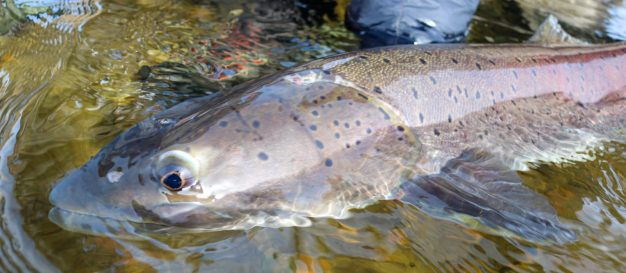 I realized that I was an obvious participant in this multicultural network during my time in the country. Instead of silk, pine nuts, or gold, I traveled halfway across the world to this historic cradle of commerce to seek a fish I revered since I was a kid; the taimen. Although their cousin, the huchen, still lurks in some of Europe’s most protected rivers, taimen now flourish in only a few pristine watersheds in Mongolia, Russia, and the Northern Islands of Japan. Like most fish at the pinnacle of the food chain, they are highly susceptible to overfishing and habitat degradation. Fortunately, in the Khovsgol Province of northern Mongolia, the local populace seems to respect the environment, thereby preserving a stronghold of these fish. I spent a week chasing taimen on the rivers Eg and Ur, where the fishing season starts at the end of the monsoon in August, and ends when the rivers start to cap with ice as October ushers in the early Mongolian winter.
I realized that I was an obvious participant in this multicultural network during my time in the country. Instead of silk, pine nuts, or gold, I traveled halfway across the world to this historic cradle of commerce to seek a fish I revered since I was a kid; the taimen. Although their cousin, the huchen, still lurks in some of Europe’s most protected rivers, taimen now flourish in only a few pristine watersheds in Mongolia, Russia, and the Northern Islands of Japan. Like most fish at the pinnacle of the food chain, they are highly susceptible to overfishing and habitat degradation. Fortunately, in the Khovsgol Province of northern Mongolia, the local populace seems to respect the environment, thereby preserving a stronghold of these fish. I spent a week chasing taimen on the rivers Eg and Ur, where the fishing season starts at the end of the monsoon in August, and ends when the rivers start to cap with ice as October ushers in the early Mongolian winter.
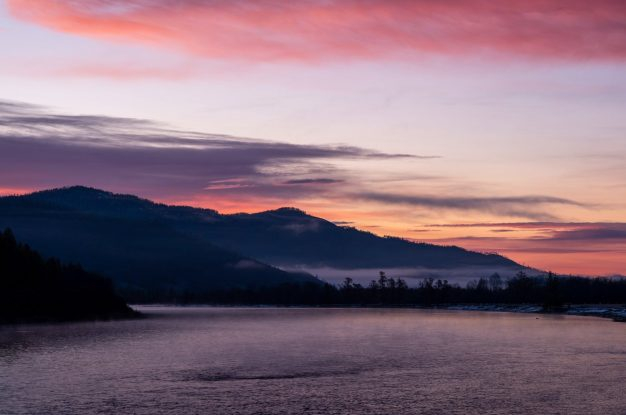 The setting felt like a parallel universe to the river valleys of southwest Montana. Larch trees lined the rivers instead of spruce stands, turning the autumnal hillsides into a scene of spectacular golden splendor before dropping their needles to the ground. The taimen behaved akin to large brown trout, brooding and unpredictable, and menacing when in the mood for a quick meal. The area was far from uninhabited, but rather than jockeying with a crowd of other drift boaters as one would on the Madison or the Big Hole, the locals seemed more interested in foraging, tending to herds of cattle and horses, and providing offerings to Buddhist monasteries that occasionally dotted the riverbanks. Although we met a handful of Mongolians fly fishing throughout the 100+ river miles we covered, we did not see another foreigner during our travels in the region.
The setting felt like a parallel universe to the river valleys of southwest Montana. Larch trees lined the rivers instead of spruce stands, turning the autumnal hillsides into a scene of spectacular golden splendor before dropping their needles to the ground. The taimen behaved akin to large brown trout, brooding and unpredictable, and menacing when in the mood for a quick meal. The area was far from uninhabited, but rather than jockeying with a crowd of other drift boaters as one would on the Madison or the Big Hole, the locals seemed more interested in foraging, tending to herds of cattle and horses, and providing offerings to Buddhist monasteries that occasionally dotted the riverbanks. Although we met a handful of Mongolians fly fishing throughout the 100+ river miles we covered, we did not see another foreigner during our travels in the region.
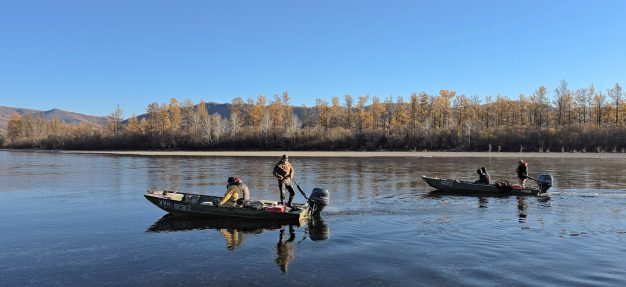 We chose the program we did for several reasons. Featuring a remote, unspoiled watershed, it lay at the heart of the world’s taimen capital on the Ur River. We were intrigued by their jet boats. While this experience was not quite as idyllic as a week in a drift boat, we decided that outboard motors would provide us with maximum opportunities on the prime taimen runs. Upon arrival at the lodge, the guides generously offered to show us the ropes for a few hours before sunset. We would not travel far from the lodge that evening. The guides simply aimed to help us grasp the approaches needed to catch taimen during the coming week. I had the fortune of drawing Bayara–the most seasoned guide in the group–for this evening of training. As Bayara would show me, fishing for taimen had similarities to some of my other fly fishing experiences. Without doubt, it was sometimes a game of 10,000 casts with a large streamer, similar to musky fishing. The mousing experience was reminiscent of hunting the carnivorous Alaskan rainbow trout in Bristol Bay. I found that I needed to deploy a fairly violent strip set, as I would to hook a hard-mouthed payara in the Amazon rainforest.
We chose the program we did for several reasons. Featuring a remote, unspoiled watershed, it lay at the heart of the world’s taimen capital on the Ur River. We were intrigued by their jet boats. While this experience was not quite as idyllic as a week in a drift boat, we decided that outboard motors would provide us with maximum opportunities on the prime taimen runs. Upon arrival at the lodge, the guides generously offered to show us the ropes for a few hours before sunset. We would not travel far from the lodge that evening. The guides simply aimed to help us grasp the approaches needed to catch taimen during the coming week. I had the fortune of drawing Bayara–the most seasoned guide in the group–for this evening of training. As Bayara would show me, fishing for taimen had similarities to some of my other fly fishing experiences. Without doubt, it was sometimes a game of 10,000 casts with a large streamer, similar to musky fishing. The mousing experience was reminiscent of hunting the carnivorous Alaskan rainbow trout in Bristol Bay. I found that I needed to deploy a fairly violent strip set, as I would to hook a hard-mouthed payara in the Amazon rainforest.
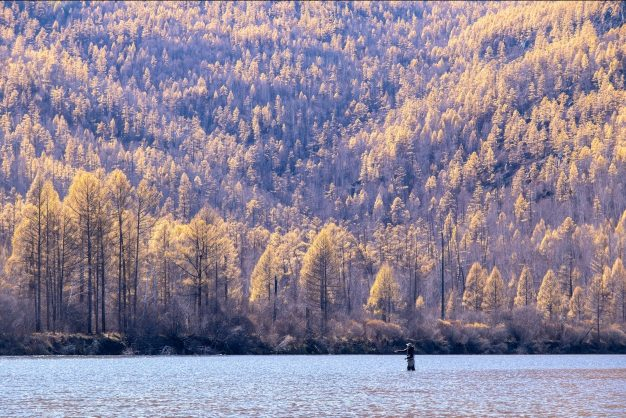
Bayara clearly preferred the topwater pursuit of mousing, and for good reason. The thought of a meter-long beast emerging from the depths to inhale a relatively small mouse was both exhilarating and absurd. We focused on mousing during the first evening, as Bayara showed us the proper technique to swing and twitch these flies in a vulnerable way that could attract our quarry. Bayara continuously reiterated the importance of a good strip set, with the rod pointed straight at the fly line as it exited the last guide. He told us that one strip set would be insufficient, and that we needed to set several times, or risk failure to drive our barbless hooks into the hard mouths of the taimen.
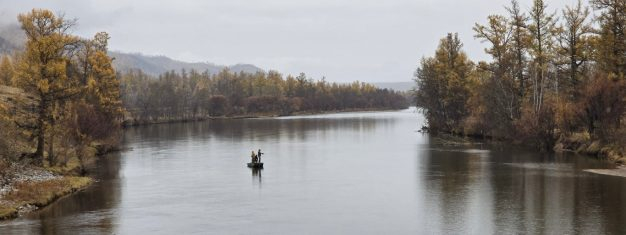 My focus intensified as the sun dipped over the ridges to our west. Worldwide, magic seems to happen in the moments after twilight consumes the final rays of the evening sun. It turns out Mongolia was no different in that way. A particularly accurate cast placed my mouse a few feet from shore, in a gentle trough behind a protruding boulder. I started to twitch the mouse in accordance with Bayara’s instructions as it began to swing downstream through the nervous, gentle chop.
My focus intensified as the sun dipped over the ridges to our west. Worldwide, magic seems to happen in the moments after twilight consumes the final rays of the evening sun. It turns out Mongolia was no different in that way. A particularly accurate cast placed my mouse a few feet from shore, in a gentle trough behind a protruding boulder. I started to twitch the mouse in accordance with Bayara’s instructions as it began to swing downstream through the nervous, gentle chop.
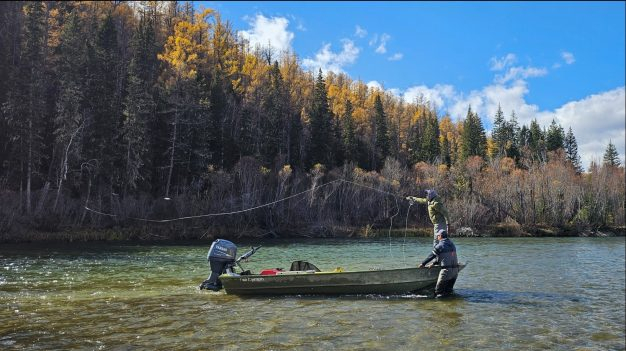 The sound of the taimen erupting through the water imprinted forever on my mind. It did not just eat the mouse; the taimen absolutely destroyed the rodent imitation. Water spewed in all directions, magnifying the viciousness of the strike. The take reminded me of one of those National Geographic videos featuring a great white shark breaching for a helpless seal. The taimen cartwheeled several feet into the air as it ate, almost landing on the bank as it finally lost its encounter with gravity and returned to earth. I hit it with several hard strip sets. The taimen pulled back with fury, as I nervously lifted my rod to begin the fight. Typical of the species, the fish did not go on any reel-screaming runs, but rather tried to bulldog me into some adjacent structure. Several nervy moments saw the fish nearly wrap my line around the aforementioned boulder and a nearby log. After a rough and brutal battle, Bayara lifted the 39-inch taimen into the net. Elated that I could get the monkey off my back during our first evening of fishing, I spent several moments with the fish before releasing it back into the river. Hastening my desire to free the fish was an odd thought that it was probably my age, as we were told that the taimen we caught were roughly the age of their length in inches. I felt a sense of gratitude and respect for this venerable creature as I watched the last of its magenta glow disappear into the opaque waters of the accelerating dusk.
The sound of the taimen erupting through the water imprinted forever on my mind. It did not just eat the mouse; the taimen absolutely destroyed the rodent imitation. Water spewed in all directions, magnifying the viciousness of the strike. The take reminded me of one of those National Geographic videos featuring a great white shark breaching for a helpless seal. The taimen cartwheeled several feet into the air as it ate, almost landing on the bank as it finally lost its encounter with gravity and returned to earth. I hit it with several hard strip sets. The taimen pulled back with fury, as I nervously lifted my rod to begin the fight. Typical of the species, the fish did not go on any reel-screaming runs, but rather tried to bulldog me into some adjacent structure. Several nervy moments saw the fish nearly wrap my line around the aforementioned boulder and a nearby log. After a rough and brutal battle, Bayara lifted the 39-inch taimen into the net. Elated that I could get the monkey off my back during our first evening of fishing, I spent several moments with the fish before releasing it back into the river. Hastening my desire to free the fish was an odd thought that it was probably my age, as we were told that the taimen we caught were roughly the age of their length in inches. I felt a sense of gratitude and respect for this venerable creature as I watched the last of its magenta glow disappear into the opaque waters of the accelerating dusk.
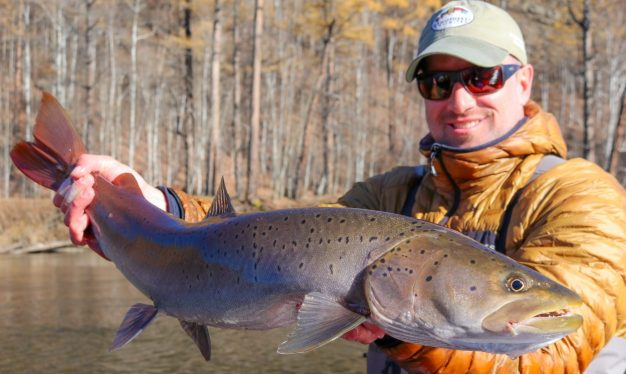
While nothing beat the hits we got on the mice, for our group, the most effective way to catch a taimen involved sinking lines and large streamers. In fact, throughout the week, we realized that the best streamer was the largest one that could be cast proficiently, over and over again. Though brighter patterns produced the most fish, the size of the fly seemed to matter more than the particular pattern or color. Bayara told me that mousing was much more productive during the warmth of the early season. However, with mere days before winter took hold of the region, the taimen responded better to our subsurface offerings.
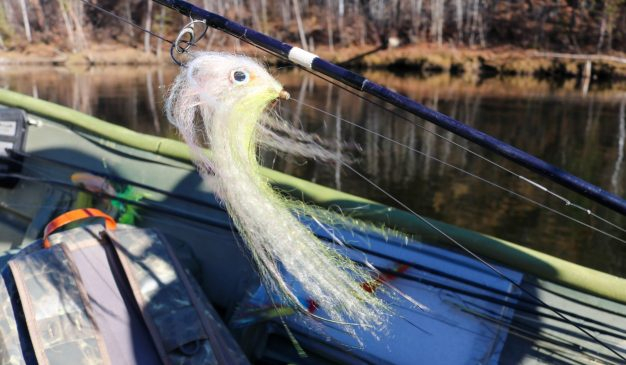 A typical day of streamer fishing for taimen involved hundreds of casts with a sinking line and a 9-weight rod, usually aiming for a bank or structure, before letting the fly swing around in the current. While swinging the fly, the guides instructed us to “twitch” it by grasping the line and either gently stripping it in or by intermittently pulling and releasing the line instead of retrieving it. The taimen had a distinctive habit of following the fly without striking immediately. Sometimes, this provided a heart stopping visual. But these follows were not always apparent given the fact that we were fishing in the late season, and the colder temperatures mostly pushed the fish into slower, deeper water. Therefore, the guides taught us to dangle the fly line at the end of each cast, while spending up to a minute teasing the fly downstream of our casting position. This dangling technique produced nearly half of our strikes throughout the week.
A typical day of streamer fishing for taimen involved hundreds of casts with a sinking line and a 9-weight rod, usually aiming for a bank or structure, before letting the fly swing around in the current. While swinging the fly, the guides instructed us to “twitch” it by grasping the line and either gently stripping it in or by intermittently pulling and releasing the line instead of retrieving it. The taimen had a distinctive habit of following the fly without striking immediately. Sometimes, this provided a heart stopping visual. But these follows were not always apparent given the fact that we were fishing in the late season, and the colder temperatures mostly pushed the fish into slower, deeper water. Therefore, the guides taught us to dangle the fly line at the end of each cast, while spending up to a minute teasing the fly downstream of our casting position. This dangling technique produced nearly half of our strikes throughout the week.
 We found a few other catchable fish species inhabiting the waters of northern Mongolia. Generally, these species were more forgiving than the taimen. They offered a welcome diversion when our wrists were sore from casting foot-long streamers, or when we simply needed to feel some positive feedback if the taimen were off the chase. We encountered lenok trout, an aggressive species resembling the progeny of a brown trout and a mountain whitefish. Lenoks eagerly engulfed nymphs and wooly buggers, and the beefier ones sometimes ate our mice when we were fishing for taimen. The guides claimed that the dry fly fishing for lenok was downright silly during the earlier part of the season. After one particularly successful lenok session, my friend exclaimed that “it felt like we were part of a secret club,” as the others in our group had not yet discovered the thrill of roping one 22-inch lenok after another. The rivers were also full of grayling, which made up for their lack of size with the sparkling maroon motifs of their dorsal fins and flanks.
We found a few other catchable fish species inhabiting the waters of northern Mongolia. Generally, these species were more forgiving than the taimen. They offered a welcome diversion when our wrists were sore from casting foot-long streamers, or when we simply needed to feel some positive feedback if the taimen were off the chase. We encountered lenok trout, an aggressive species resembling the progeny of a brown trout and a mountain whitefish. Lenoks eagerly engulfed nymphs and wooly buggers, and the beefier ones sometimes ate our mice when we were fishing for taimen. The guides claimed that the dry fly fishing for lenok was downright silly during the earlier part of the season. After one particularly successful lenok session, my friend exclaimed that “it felt like we were part of a secret club,” as the others in our group had not yet discovered the thrill of roping one 22-inch lenok after another. The rivers were also full of grayling, which made up for their lack of size with the sparkling maroon motifs of their dorsal fins and flanks.

Additionally, the sloughs adjacent to the main rivers were home to a few northern pike. The guides downplayed the chances of catching pike, stating they were few in number and that the existing ones were difficult to tempt. I was able to fool one decent pike, and I had a feeling that this species may offer a bit of an unrealized opportunity within the fishery.
 Although the other species certainly intrigued us, taimen were the reason we traveled across ten time zones to cast a fly. Taimen fly fishing was not a numbers game, and it required a bit of mental fortitude to perform successfully. At times, we made perfect casts for hours without sniffing a taimen, especially when the weather was calm and sunny. However, there were definitely feeding windows, and we encountered several of these throughout our week. One of these feeding windows produced a period of insanity on the last afternoon of our trip.
Although the other species certainly intrigued us, taimen were the reason we traveled across ten time zones to cast a fly. Taimen fly fishing was not a numbers game, and it required a bit of mental fortitude to perform successfully. At times, we made perfect casts for hours without sniffing a taimen, especially when the weather was calm and sunny. However, there were definitely feeding windows, and we encountered several of these throughout our week. One of these feeding windows produced a period of insanity on the last afternoon of our trip.
 On this day, Bayara took my friend Ben and me further upriver than any angler had traveled during our week. Bayara steered us into position at the top of a long, deep run at the end of a mid-river island. The area looked like prototypical taimen water. Within a few casts, Ben was hooked up with a prime specimen, which proceeded to tow our boat around an adjacent lagoon. No stranger to large salmonids, and with ample room to operate within the pool, Ben had little trouble corralling the fish into Bayara’s waiting net. It was immediately apparent that this fish was a bit different than most of the others we encountered. Some taimen exhibited a fairly slender body type. While in no way indicating a lack of health, this feature made some of them look less impressive and more snakelike in photographs than they seemed in person. Ben’s taimen did not suffer from this affliction. Large in every proportion, Ben’s fish was an absolute unit and a fish of a lifetime. Its protuberant belly sagged near the water’s surface as Ben struggled to lift it for a quick picture. Bayara fumbled with his tape measure, adjusting his glasses as he struggled to grasp the magnitude of the fish. Of course, Bayara had encountered larger taimen over the years, but this was one of the best of the season.
On this day, Bayara took my friend Ben and me further upriver than any angler had traveled during our week. Bayara steered us into position at the top of a long, deep run at the end of a mid-river island. The area looked like prototypical taimen water. Within a few casts, Ben was hooked up with a prime specimen, which proceeded to tow our boat around an adjacent lagoon. No stranger to large salmonids, and with ample room to operate within the pool, Ben had little trouble corralling the fish into Bayara’s waiting net. It was immediately apparent that this fish was a bit different than most of the others we encountered. Some taimen exhibited a fairly slender body type. While in no way indicating a lack of health, this feature made some of them look less impressive and more snakelike in photographs than they seemed in person. Ben’s taimen did not suffer from this affliction. Large in every proportion, Ben’s fish was an absolute unit and a fish of a lifetime. Its protuberant belly sagged near the water’s surface as Ben struggled to lift it for a quick picture. Bayara fumbled with his tape measure, adjusting his glasses as he struggled to grasp the magnitude of the fish. Of course, Bayara had encountered larger taimen over the years, but this was one of the best of the season.
 Ben managed to tag yet another worthy taimen in the same hole before we moved upstream, where it was my turn to get in on the action. The next likely spot was sublime in appearance. A steady riffle transitioned to a single prominent run. The water toward the end of the run looked interminably deep as the current dog-legged to the right against a cliff and formed a gigantic pool. Surely there would be taimen somewhere in this perfect spot.
Ben managed to tag yet another worthy taimen in the same hole before we moved upstream, where it was my turn to get in on the action. The next likely spot was sublime in appearance. A steady riffle transitioned to a single prominent run. The water toward the end of the run looked interminably deep as the current dog-legged to the right against a cliff and formed a gigantic pool. Surely there would be taimen somewhere in this perfect spot.
 And taimen there were. They were schooled up on the inside edge of the run, just where the water became slow and deep. For a species that sometimes made us wonder if it was fish or mythical beast, it was jarring to hook taimen on four straight casts. I only landed two of them on account of some sloppy strip sets (which were all too easy for Bayara to critique). All four taimen were tremendous fish, each pushing or exceeding 40 inches. Unfortunately, as so often happens, the biggest of the lot spit the hook right behind the boat, just as the net was being deployed. It looked like a mature tarpon as it turned broadside to the boat and shook its head with fury, dislodging the fly from its bucket-shaped mouth. Though disappointing, losing that fish gave me even more reason to plan a return trip one day. Like a weary traveler in a Silk Road caravan, I will certainly visit this splendid place again, seeking not textiles or spices, but the incredible fish that call this land home.
And taimen there were. They were schooled up on the inside edge of the run, just where the water became slow and deep. For a species that sometimes made us wonder if it was fish or mythical beast, it was jarring to hook taimen on four straight casts. I only landed two of them on account of some sloppy strip sets (which were all too easy for Bayara to critique). All four taimen were tremendous fish, each pushing or exceeding 40 inches. Unfortunately, as so often happens, the biggest of the lot spit the hook right behind the boat, just as the net was being deployed. It looked like a mature tarpon as it turned broadside to the boat and shook its head with fury, dislodging the fly from its bucket-shaped mouth. Though disappointing, losing that fish gave me even more reason to plan a return trip one day. Like a weary traveler in a Silk Road caravan, I will certainly visit this splendid place again, seeking not textiles or spices, but the incredible fish that call this land home.
About the Lodge
The Eg Ur program Lodge provided an impressive degree of comfort given the austerity of the setting. Each angler was paired with another in a Mongolian ger; the mobile yurt found throughout the Mongolian countryside. The traditional gers we slept in were similar to the gers that Chinggis Khan used nearly a thousand years ago.
 A wood-burning stove was the centerpiece of the ger, which otherwise provided ample room and shelter from the frosty temperatures outside. One of the camp staff stealthily snuck into the tent before dawn to light the stove and warm the ger before we got out of bed. Admittedly, I found this practice a bit strange at first, but as the week progressed I began to anticipate the warmth it provided, as it made for comfortable awakenings during those crispy, late fall mornings.
A wood-burning stove was the centerpiece of the ger, which otherwise provided ample room and shelter from the frosty temperatures outside. One of the camp staff stealthily snuck into the tent before dawn to light the stove and warm the ger before we got out of bed. Admittedly, I found this practice a bit strange at first, but as the week progressed I began to anticipate the warmth it provided, as it made for comfortable awakenings during those crispy, late fall mornings.

The main lodge sat adjacent to the half-circle of gers on a spectacular bluff overlooking the river. This was a large cabin-like structure, where the meals and the bulk of the socializing happened.
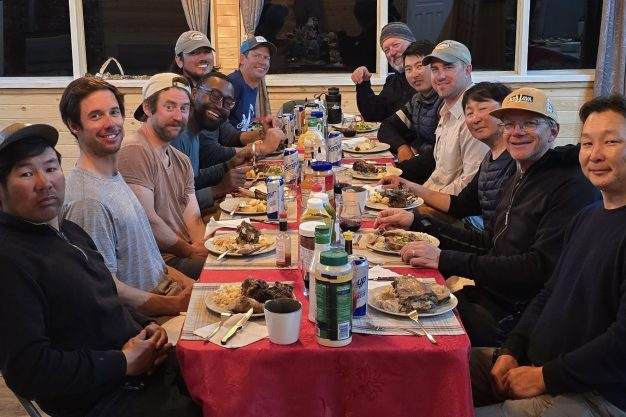
Breakfast and dinner included tasty combinations of American-style food and traditional Mongolian dishes. Lunch was served on the river. The week culminated with a lively performance from local musicians and dancers, who generously shared a bit of the regional culture with us before our departure.
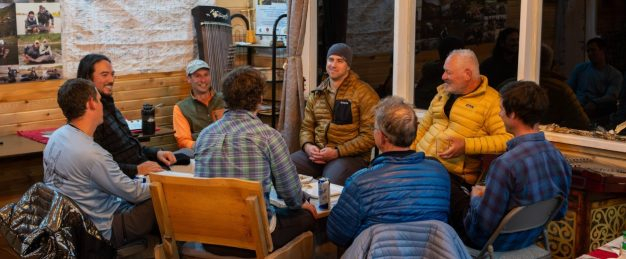 The fishing happened over four beats: the upper Ur, the lower Ur, the upper Eg, and the lower Eg below the confluence with the Ur. The entire camp was strategically situated on the Ur River at the junction of the upper and lower beats. The word “beat” failed to describe the vastness of these segments, as each contained 20-40 river miles. Individually, a single beat could have sustained the entire group of eight anglers for the week. There was one boat and guide with two anglers per beat, and all anglers experienced each of the four beats before randomly repeating two of them on the fifth and sixth day.
The fishing happened over four beats: the upper Ur, the lower Ur, the upper Eg, and the lower Eg below the confluence with the Ur. The entire camp was strategically situated on the Ur River at the junction of the upper and lower beats. The word “beat” failed to describe the vastness of these segments, as each contained 20-40 river miles. Individually, a single beat could have sustained the entire group of eight anglers for the week. There was one boat and guide with two anglers per beat, and all anglers experienced each of the four beats before randomly repeating two of them on the fifth and sixth day.

Getting There
Travel to the Eg Ur Lodge was an adventure in itself, but the journey was not nearly as painful as we feared. We found that most convenient itineraries from North America linked through Seoul, although we also considered routes through Istanbul, Beijing, and Hong Kong. Seoul impressed us, and we were pleased to spend a couple of days in this historic city while we recovered from some jet lag. From there, it was a four-hour flight to Ulaanbaatar, and a night of relaxation at one of the better hotels in town. Finally, the group was whisked away by a private airplane departing from a small domestic airport, landing on an airstrip directly next to the camp two hours later.
